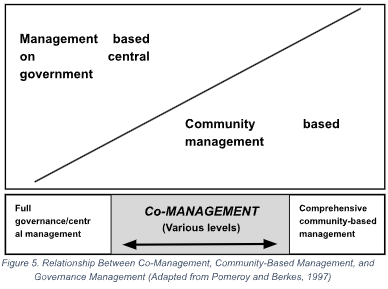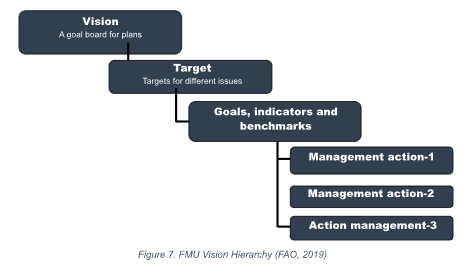CHAPTER III. Fisheries Management in Inland Waters
3.1. Stakeholders Involvement
Once stakeholders have been identified, it is necessary to understand their attitudes and positions about EAFM. The observations were made to ensure the participation of all key stakeholders. Expanding stakeholder involvement in the management process is a key principle of EAFM. Through consultation and negotiation, the partners can develop a formal agreement on their respective roles, responsibilities, and rights in management. Those involved in EAFM have rights and responsibilities in designing and implementing managerial action.
Stakeholder engagement continues throughout the EAFM process and is continuously developed. Stakeholder engagement activities build institutional knowledge of the EAFM team, key stakeholders, and participating partners, agencies, and institutions. The benefits of stakeholder engagement (participatory) in general include:
-
Enabling processes of empowerment that encourage trust and independence and it can be catalysts for change;
-
Cost-effectiveness;
-
Fast in implementing the EAFM plan;
-
Promote a greater sense of ownership; and
-
Building relationships and partnerships.
The three pillars of a participatory approach:
-
Attitude and behavior: the attitude and behavior of the facilitator are very important for participatory success. The facilitator must be neutral, manage the discussion fairly, and involve all present.
-
Medium: Various mediums can be used to get the population's participation. The tools are only effective with the attitude and behavior described above.
-
Share: sharing information, knowledge, opinions, and feelings is a key element of a participatory process. This sharing empowers people, and problems can be discussed, resolved, or brought into open discussion forums.
The participatory approach aims to empower communities and groups that are most vulnerable and can meet their needs so that their interests are represented in every decision-making. For the EAFM process to be successful, the men and women of resource users, local organizations, communities, local government officials, and other stakeholders must be active in taking control and making decisions. To implement them, they must increase awareness and understanding of fisheries resource management within an ecosystem.
Co-management
The ecosystem approach and co-management have a strong relationship (interdependence) (see Figure 5).
Co-management can also be defined as partnership arrangements in which local resource user communities, governments, other stakeholders, and external agencies share responsibility and authority for fisheries management, with varying levels of power sharing.
Some of the benefits of co-management include:
-
accountable, transparent, and autonomous management processes;
-
a more democratic and participatory society;
-
more economical than centralized systems;
-
fishers and key stakeholders take responsibility for some managerial functions;
-
communities and resource users develop flexible and creative management strategies which meet specific needs and conditions;
-
local solutions for local problems; and
-
Improve public services and awareness of water management and coastal resources.
The co-management approach can be applied at any scale, from single scale, multi-stakeholder, multi-resource, and multi-use situations, which will emerge in integrated management. Increasing awareness is a very important element in transforming stakeholders into active partners in co-management. As part of the EAFM stakeholder engagement process, awareness-raising campaigns should include activities relevant to stakeholders and their sustainability goals, emphasizing the link between activities using local resources and environmental quality.
The success of co-management is directly related to well-organized communities that have been empowered to manage and conserve fish resources and the environment. Community mobilization for EAFM is much more complex than just building an organization. It starts from the empowerment process, building awareness, introducing new values and behaviors, building independence, building relationships, developing organization and leadership, and enabling communities to take action. Thus, the community is ready to participate and contribute to the EAFM process through co-management.
3.2. Fisheries Management Unit in Inland Waters
Defining the managed area or Fisheries Management Unit (FMU) is very important in implementing EAFM. FMU in inland waters can be applied based on geographical aspects, types of fish, types of fishing gear used, or a combination of several existing aspects. As shown in Figure 6, ideally, the selected FMU should:
-
associated with some ecological constraints;
-
covers the entire fishing area;
-
includes target fish species; And,
-
cover all types of existing fishing gear.
After defining the FMU, it is very important to agree on the vision of the FMU, which contains the desired positive conditions for the future. FMU's vision must align with national/regional policies and applicable laws and regulations. FMU's vision is then translated into goals, objectives, indicators, benchmarks, and managerial action that are carried out according to the threats and issues faced (Figure 7).
Once the location and boundaries of the FMU have been defined. Then, the vision agreed upon, the FMU profile also needs to be created as:
-
basis of all planning and management of EAFM activities.
-
basis for monitoring and evaluating future performance.
The FMU profile includes various information on the technical, social, resource, and political conditions so that the FMU profile can answer key questions:
-
What are the current conditions, patterns, and problems with resource use?; and
-
What are the patterns of access to resources between genders, ethnic groups, and social hierarchies?
EAFM is an adaptive management process, a lack of information should not preclude managerial action but should still be implemented with a precautionary approach. Existing information and local knowledge can be utilized but needs to be verified and validated.
The information displayed in the FMU profile includes scientific information and indigenous/local knowledge. The information collected will differ depending on the research method and the capacities of the people collecting the data. The scope of the FMU profile reflects the EAFM component. It contains information on resources, ecology, social and economics, governance, and institutions.
Data can be either quantitative or qualitative. Quantitative data are numerical measures, namely "who, what, when, where, how much, how much, how often," obtained through standardized interviews, biophysical surveys, and closed-ended surveys. Qualitative data often refers to "hows and whys" and can be obtained informally through free and guided interviews (including focus group discussions); surveys using open-ended questions; participatory methods; observation; and document interpretation.




No Comments